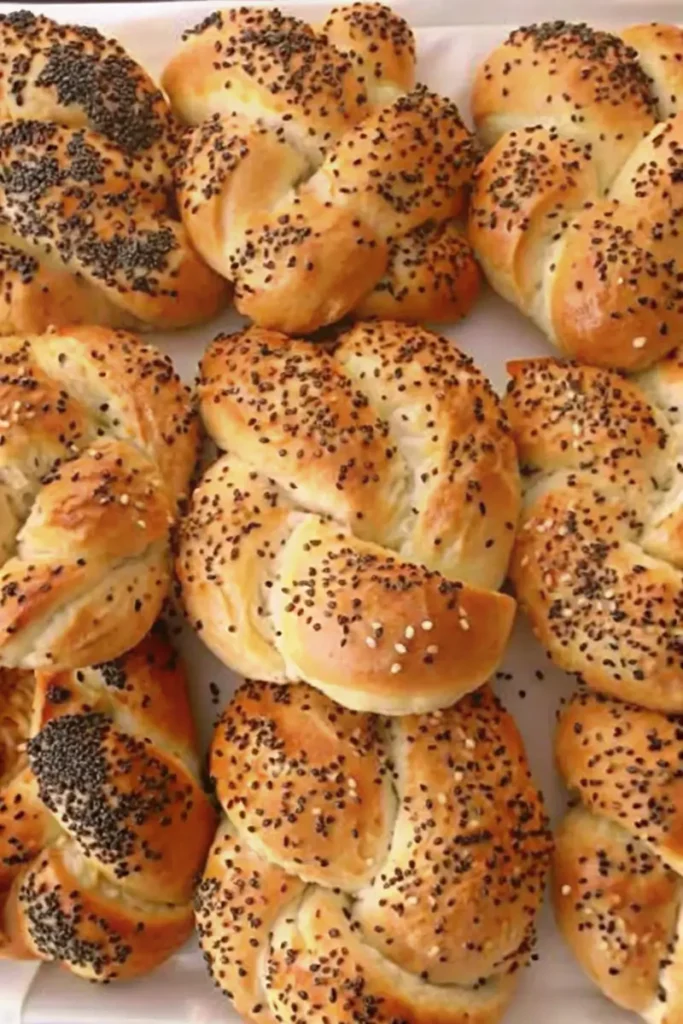When it comes to bread, few options match the charm and versatility of the Kaiser roll. This classic Austrian creation has made its way into bakeries and homes worldwide, becoming a beloved choice for sandwiches, burgers, and even breakfast delights. But what exactly makes this roll so special? Dive in as we unravel the history, taste, and all the secrets behind crafting the perfect Kaiser roll. Let’s get rolling!
What is a Kaiser Roll?
A Brief History of Kaiser Rolls
Did you know the Kaiser roll traces its origins to 18th-century Austria? Known as the Vienna roll, it was created to honor Emperor Franz Joseph I—hence the term “Kaiser,” meaning “emperor.” Its signature star-shaped top isn’t just a random design; it symbolizes a crown, adding a regal touch to this humble bread.
Through the years, the Kaiser roll has gained popularity for its crusty exterior and pillowy interior. While traditional recipes called for simple ingredients like flour, yeast, and water, modern variations have introduced seeds like poppy or sesame for extra flair. Today, it’s a staple in many cuisines and remains a go-to for sandwiches, burgers, and more.
Unique Features of Kaiser Rolls
So, what sets the Kaiser roll apart? Its distinct star-shaped design is achieved using a special mold or stamp, giving the roll its characteristic appearance. But it’s not all about looks—the texture is a game-changer too! With a crispy crust and soft, airy crumb, it balances chewiness and lightness perfectly. Whether you’re crafting a deli sandwich or indulging in a breakfast roll, the Kaiser roll shines in both flavor and presentation.
Why You’ll Love Kaiser Rolls
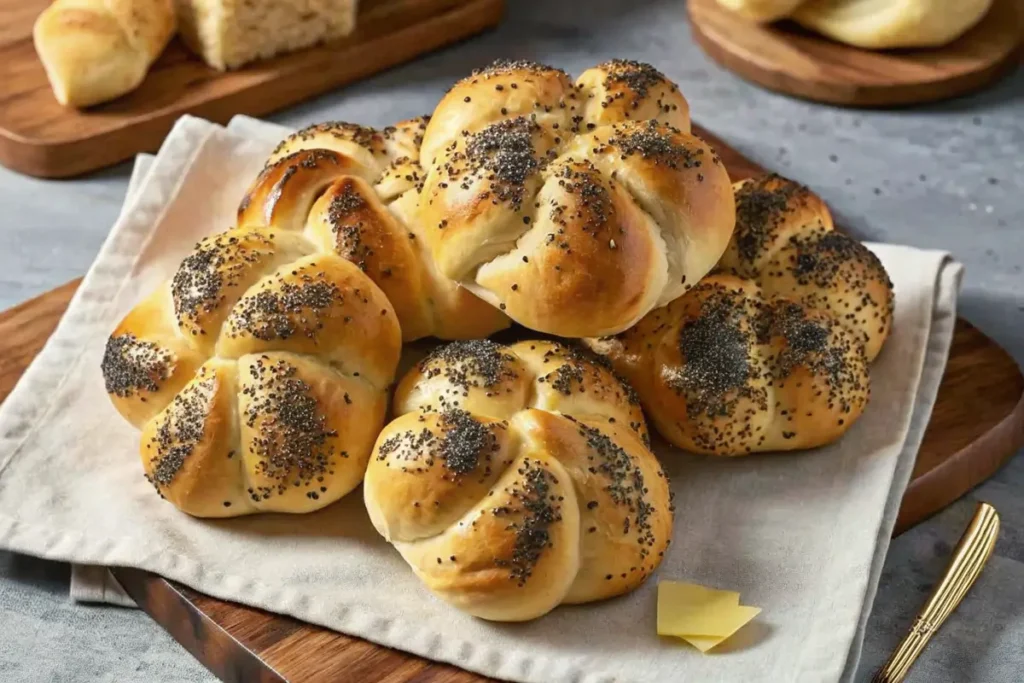
Versatility in Use
If there’s one thing that makes Kaiser rolls a crowd-pleaser, it’s their incredible versatility. These rolls are the ultimate blank canvas for all your culinary creations. Whether you’re building the perfect sandwich or looking for a base for a gourmet burger, Kaiser rolls have you covered. They’re sturdy enough to hold hearty fillings yet soft enough to make every bite delightful. Oh, and they’re fantastic for breakfast too! Slather on some butter, pile on scrambled eggs, or go sweet with a dollop of jam—there’s no wrong way to enjoy them.
Irresistible Taste and Texture
What makes Kaiser rolls so memorable is their unique combination of taste and texture. The crispy, golden crust offers just the right amount of crunch, while the inside remains fluffy and tender. Each bite is a delightful contrast, making them perfect for those who appreciate a bread that’s not too dense but still hearty enough to satisfy. Plus, the subtle flavor pairs wonderfully with everything from savory meats to creamy spreads.
So, why settle for plain, boring bread when you can have a Kaiser roll? These versatile, delicious rolls will make every meal feel like a treat!
Health Benefits and Nutritional Profile
Are Kaiser Rolls Healthy?
Let’s dive into the million-dollar question—are Kaiser rolls good for you? While they might not be a health food per se, they can certainly fit into a balanced diet. Made primarily from flour, yeast, and water, they’re relatively simple in composition. Traditional Kaiser rolls are low in sugar and contain modest amounts of protein and fiber, making them a decent choice compared to overly processed bread options.
For those watching their carb intake or looking for more nutritious options, whole-grain or multigrain Kaiser rolls are excellent alternatives. These versions boast higher fiber content, which helps keep you feeling full and supports healthy digestion.
Nutritional Information
A typical Kaiser roll (approximately 80 grams) contains:
- Calories: 220-260
- Carbohydrates: 40-45 grams
- Protein: 7-9 grams
- Fat: 1-2 grams
- Fiber: 1-3 grams (higher in whole-grain versions)
The low-fat and low-sugar profile makes Kaiser rolls a guilt-free addition to your meals when consumed in moderation.
Variations for Dietary Needs
If you have dietary restrictions, fret not! Bakers have created variations of the classic Kaiser roll to suit different needs:
- Whole-grain Kaiser rolls: Packed with fiber and nutrients.
- Gluten-free Kaiser rolls: Opt for a gluten-free version crafted with alternative flours such as almond or rice flour.
- Low-sodium options: Perfect for those managing sodium intake.
By choosing the right type of Kaiser roll, you can enjoy this delicious bread without compromising your health goals. Who says bread can’t be both tasty and smart?
How to Make Kaiser Rolls at Home
Ingredients You’ll Need
Making Kaiser rolls at home is easier than you think, and the reward? Fresh, warm, golden rolls that taste even better than bakery ones! Here’s what you’ll need for a traditional batch:
- 4 cups of all-purpose flour (or bread flour for extra chewiness)
- 1 tablespoon sugar
- 1 ½ teaspoons salt
- 2 ¼ teaspoons instant yeast (or one packet)
- 1 ¼ cups warm water (about 110°F)
- 3 tablespoons unsalted butter (softened)
- 1 large egg (for the egg wash)
- Optional toppings: Poppy seeds, sesame seeds, or coarse salt
Tip: Using bread flour will give your rolls a chewier texture, while all-purpose flour results in a softer crumb. Both are delicious, so feel free to experiment!
Step-by-Step Instructions
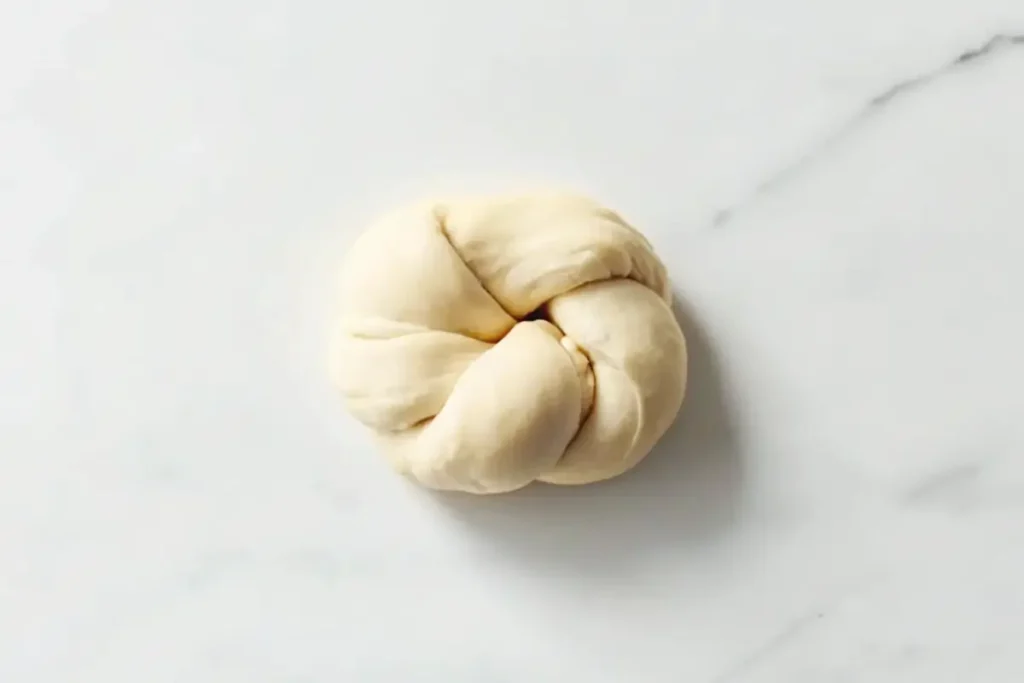
- Activate the Yeast
In a small bowl, combine warm water and sugar. Sprinkle the yeast over the top and let it sit for 5-10 minutes until frothy. This step ensures your yeast is alive and ready to work its magic. - Mix the Dough
In a large mixing bowl, combine the flour and salt. Add the yeast mixture and softened butter. Stir until the dough starts to come together. - Knead the Dough
Transfer the dough to a floured surface and knead for 8-10 minutes until smooth and elastic. Alternatively, use a stand mixer with a dough hook for 5-7 minutes. - Let it Rise
Place the dough in a lightly oiled bowl, cover it with a damp towel or plastic wrap, and let it rise in a warm place for 1-2 hours until it doubles in size. - Shape the Rolls
Divide the dough into 8 equal pieces. Roll each piece into a ball, then shape it into the classic star pattern using a Kaiser roll stamp or by tying the dough into a knot and flattening it slightly. - Second Rise
Place the shaped rolls on a parchment-lined baking sheet, cover lightly with a towel, and let them rise for another 30-45 minutes. This step ensures they’ll be light and fluffy. - Prepare the Egg Wash
Beat the egg with a tablespoon of water and brush it generously over the rolls. Sprinkle your favorite toppings, like sesame seeds or poppy seeds, for extra flavor and crunch. - Bake to Perfection
Preheat your oven to 400°F (200°C). Bake the rolls for 15-18 minutes or until they’re golden brown and sound hollow when tapped on the bottom. - Cool and Enjoy
Transfer the rolls to a wire rack to cool slightly before serving. The aroma will be irresistible, but giving them a few minutes to cool enhances their texture.
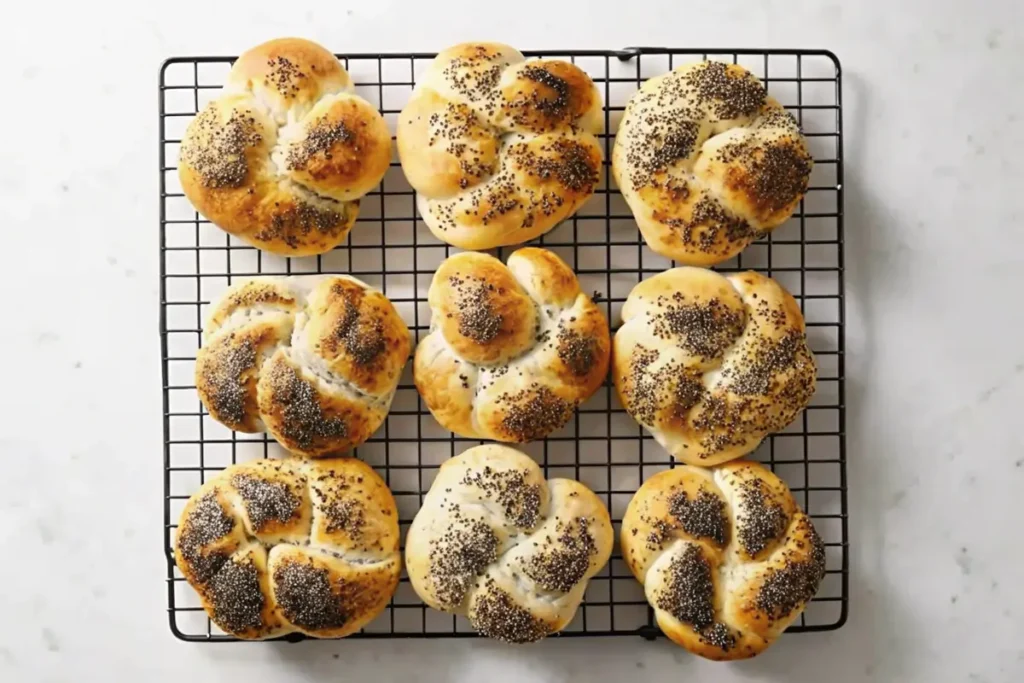
Common Mistakes to Avoid
- Skipping the second rise: This step is crucial for achieving a fluffy interior.
- Using water that’s too hot: Water hotter than 120°F can kill the yeast.
- Not scoring deeply enough: If you’re using a stamp or knife, make sure the pattern is deep enough to hold its shape during baking.
Making Kaiser rolls from scratch is a fun and rewarding experience. Plus, nothing beats the satisfaction of biting into a freshly baked roll you made with your own two hands!
Tips for the Perfect Kaiser Roll
Shaping the Perfect Star Pattern
One of the most distinctive features of a Kaiser roll is its stunning star-shaped design. But don’t worry if you’re not a professional baker—you can achieve this iconic look with a few simple tricks:
- Use a Kaiser Roll Stamp: This handy tool creates the classic pattern effortlessly. Press it firmly into the dough before the second rise.
- Go Traditional with Hand-Shaping: Roll each dough piece into a rope, tie it into a loose knot, and tuck the ends under to form a star-like shape.
- Score with a Knife: If you don’t have a stamp, use a sharp knife to cut five shallow slits around the top of each roll.
Whichever method you choose, take your time, and remember—practice makes perfect!
Achieving the Perfect Crust
A Kaiser roll without its signature crust is like a sandwich without filling. Here’s how to ensure a delightfully crisp exterior:
- Steam Baking: Place a small pan of hot water at the bottom of your oven during baking. The steam helps create that coveted crispy crust.
- Egg Wash Magic: Brushing the rolls with an egg wash before baking not only gives them a golden hue but also contributes to their crunch.
- Preheating the Oven: Ensure your oven is fully preheated to 400°F (200°C) before you bake. A hot oven is crucial for a crisp crust.
Other Handy Tips
- Don’t Rush the Rise: Allow the dough enough time to rise properly. This ensures a light and airy texture.
- Experiment with Toppings: Sesame seeds, poppy seeds, or even a mix of both can add a delightful flavor and visual appeal.
- Bake in Batches: If your oven can’t accommodate all the rolls at once, bake them in batches to ensure even cooking.
With these tips, your homemade Kaiser rolls will not only taste bakery-quality but look like a masterpiece, too. Once you master these techniques, you’ll have a bread that’s as impressive as it is delicious!
How to Store and Use Kaiser Rolls
Best Practices for Storing Kaiser Rolls
Freshly baked Kaiser rolls are undeniably delicious, but proper storage ensures you can enjoy them later without compromising their quality. Here’s how to keep them at their best:
- Room Temperature: Store rolls in an airtight container or a resealable bag for up to 2 days. Keep them in a cool, dry place away from direct sunlight.
- Refrigeration: While not ideal for texture, refrigeration can extend their shelf life to about 5-7 days. To restore softness, warm them in the oven for a few minutes.
- Freezing: Planning to save some for later? Freeze the rolls in a zip-top bag with as much air removed as possible. They’ll stay fresh for up to 3 months.
Pro Tip: To prevent freezer burn, wrap each roll individually in plastic wrap before placing them in the bag. When ready to eat, thaw at room temperature and crisp them in the oven for 5 minutes.
Creative Uses for Leftover Kaiser Rolls
Got leftover Kaiser rolls? Don’t let them go to waste! Their sturdy texture makes them perfect for a variety of dishes:
- Homemade Breadcrumbs: Toast the rolls until dry, then blitz them in a food processor. Use the crumbs for breading chicken, topping casseroles, or thickening soups.
- Croutons: Cube the rolls, toss with olive oil and seasoning, and bake until golden for crispy croutons.
- French Toast: Day-old Kaiser rolls make the perfect base for rich, custardy French toast.
- Stuffing: Chop the rolls into small pieces, mix with herbs and broth, and bake for a flavorful stuffing.
Reheating Tips
To revive your Kaiser rolls, preheat your oven to 350°F (175°C), wrap the rolls in foil, and bake for 5-7 minutes. For an extra-crispy crust, remove the foil for the last 2 minutes.
Whether freshly baked or repurposed into something new, Kaiser rolls are wonderfully versatile. With proper storage and a little creativity, you can enjoy them long after they come out of the oven!
Popular Recipes Using Kaiser Rolls
Delicious Sandwich Ideas
Kaiser rolls are the ultimate foundation for creating mouthwatering sandwiches. Thanks to their sturdy structure and soft interior, they pair well with a variety of fillings. Here are some irresistible ideas to try:
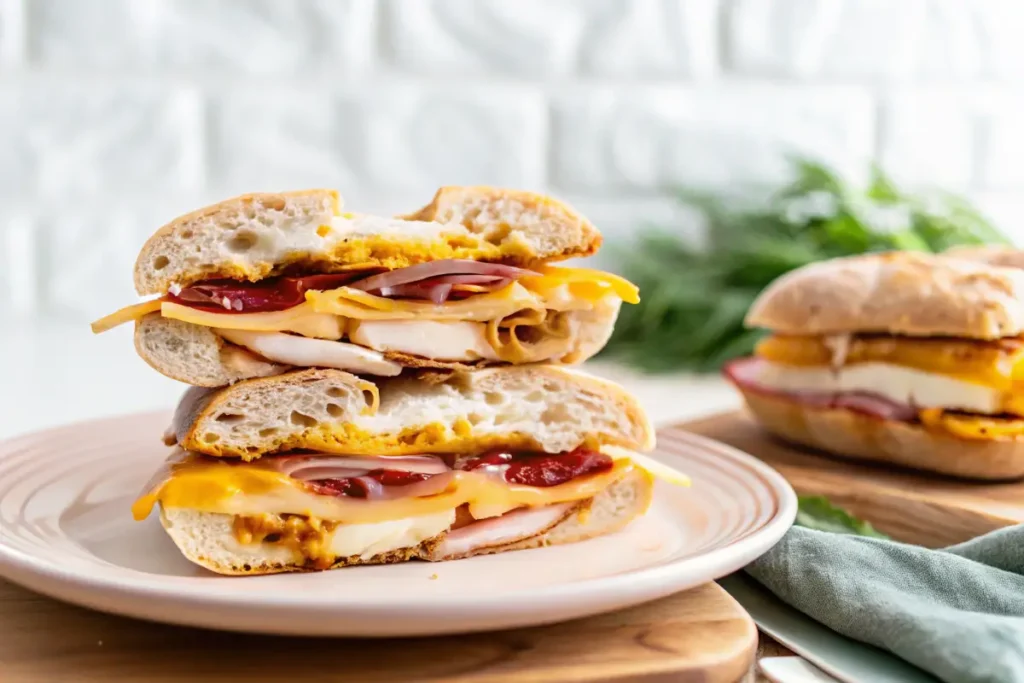
- Classic Turkey Club: Layer roasted turkey, crisp lettuce, juicy tomatoes, and creamy mayonnaise for a timeless favorite.
- Grilled Chicken Caesar Sandwich: Fill your roll with grilled chicken, romaine lettuce, parmesan, and Caesar dressing for a twist on the classic salad.
- Veggie Delight: Pile on roasted vegetables, hummus, and a sprinkle of feta cheese for a vegetarian delight.
- Tuna Salad Sandwich: Spread creamy tuna salad on a halved Kaiser roll and top with crisp lettuce and thinly sliced cucumbers for a refreshing, protein-packed option.
Beyond Sandwiches
While sandwiches are a natural fit for Kaiser rolls, these rolls can also be the star of creative dishes:
- Gourmet Burgers: Elevate your burger game with a Kaiser roll. Its crusty exterior holds up beautifully to juicy patties and toppings like caramelized onions and avocado.
- Sliders: Make mini versions with smaller Kaiser rolls—perfect for appetizers or a party spread.
- Breakfast Rolls: Start your day right by stuffing a roll with scrambled eggs, spinach, and melted cheese.
Open-Faced Sandwiches and Tartines
For a lighter option, turn your Kaiser roll into an open-faced sandwich:
- Avocado Toast with a Twist: Spread mashed avocado over half a roll, add a sprinkle of chili flakes, and top with a poached egg.
- Smoked Salmon Delight: Add cream cheese, smoked salmon, capers, and red onion for a luxurious treat.
Unique Uses for Kaiser Rolls
Don’t stop at sandwiches! These recipes will show you how versatile Kaiser rolls can be:
- Garlic Bread: Slice a roll in half, slather it with garlic butter, and bake until golden.
- Bread Bowls: Hollow out a roll and fill it with soups like potato soup, tomato bisque or clam chowder.
- Pizza Rolls: Top a halved roll with marinara sauce, mozzarella, and your favorite pizza toppings before baking.
Whether you’re hosting a gathering or whipping up a quick meal, these recipes prove that Kaiser rolls are far more than just a sandwich bread—they’re a culinary canvas waiting for your creativity!
FAQs About Kaiser Rolls
What is the Difference Between a Kaiser Roll and a Bun?
Kaiser rolls have a crispy crust and soft, airy interior, while buns are typically softer and sweeter throughout. Kaiser rolls are perfect for hearty sandwiches, while buns are often used for burgers or hot dogs.
What’s the Difference Between a French Roll and an Italian Roll?
French rolls are crusty with a light interior, great for delicate sandwiches. Italian rolls are denser and chewier, ideal for saucy or heavy fillings like meatball subs.
What Do You Put on a Kaiser Roll?
You can fill Kaiser rolls with savory options like grilled chicken, or egg and cheese. Sweet toppings like jam, honey, or Nutella work beautifully too. For a gourmet twist, try smoked salmon, avocado, or prosciutto.

